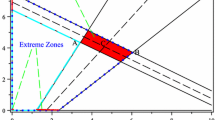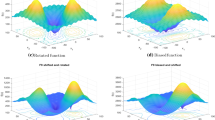Abstract
Over the past several decades, the optimization over the efficient set has seen a substantial development. The aim of this paper is to provide a state-of-the-art survey of the development. Given p linear criteria c 1x,ċċċ,cp x and a feasible region X of R n, the linear multicriteria problem is to find a point x of X such that no point x' of X satisfies (c1 x',ċċċ,cp x')≥(c1 x,ċċċ,cp x) and (c1x',ċċċ,cp x')≠q (c1 x ,ċċċ,cp x). Such a point is called an efficient point. The optimization over the efficient set is the maximization of a given function φ over the set of efficient points. The difficulty of this problem is mainly due to the nonconvexity of this set. The existing algorithms for solving this problem could be classified into several groups such as adjacent vertex search algorithm, nonadjacent vertex search algorithm, branch-and-bound based algorithm, Lagrangian relaxation based algorithm, dual approach and bisection algorithm. In this paper we review a typical algorithm from each group and compare them from the computational point of view.
Similar content being viewed by others
References
Al-Khayyal, F.A. and Falk, J.E. (1983), Jointly constrained biconvex programming. Mathematics of Operations Research 8, 273–286.
An, L.T.H., Tao, P.D. and Muu, L.D. (1996), Numerical solution for optimization over the efficient set by d.c. optimization algorithms. Operations Research Letters 19, 117–128.
Atteia, M. and El Qortobi, Quasi-convex duality. In Optimization and Optimal Control,Lecture Notes in Control and Information Science 35, Springer, Berlin, 1981, pp. 3–8.
Benson, H.P. (1991), An all-linear programming relaxation algorithm for optimizing over the efficient set. Journal of Global Optimization 1, 83–104.
Benson, H.P. (1992), A finite nonadjacent extreme-point search algorithm for optimization over the efficient set. Journal of Optimization Theory and Applications 73, 47–64.
Benson, H.P. (1995), A geometric analysis of the efficient outcome set in multiple objective convex program with linear criteria functions. Journal of Global Optimization 6, 213–251.
Benson, H.P. and Lee, D. (1996), Outcome-based algorithm for optimizing over the efficient set of a bicriteria linear programming. Journal of Optimization Theory and Applications 88, 77–105.
Benson, H.P. and Sayin, S. (1994), Optimization over the efficient set: four special case. Journal of Optimization Theory and Applications 80, 3–18.
Bolintineanu, S. (1993), Minimization of a quasi-concave function over an efficient set. Mathematical Programming 61, 89–110.
Chen, P.C., Hansen, P. and Jaumard, B. (1991), On-line and off-line vertex enumeration by adjacency lists. Operations Research Letters 10, 403–409.
Dauer, J.P. and Fosnaugh, T.A. (1995), Optimization over the efficient set. Journal of Global Optimization 7, 261–277.
Ecker, J.G. and Song, J.H. (1994), Optimizing a linear function over an efficient set. Journal of Optimization Theory and Applications 83, 541–563.
Fülöp, J. (1994), A cutting plane algorithm for linear optimization over the efficient set. In S. Komlösi, T. Rapcsàk and S. Shaible (eds.), Generalized Convexity, Lecture Notes in Economics and Mathematical Systems 405, Springer, Berlin, pp. 374–385.
Garay, M.R. and Johnson, D.S. (1979), Computers and Intractability: A Guide to the Theory of NP-Completeness. Freeman, San Francisco.
Horst, R., de Vries, J. and Thoai, N.V. (1988), On finding new vertices and redundant constraints in cutting plane algorithms for global optimization. Operations Research Letters 7, 85–90.
Horst, R. and Thoai, N.V. (1999), Maximizing a concave function over the efficient or weaklyefficient set. European Journal of Operational Research 117, 239–252.
Horst, R. and Tuy, H. (1996), Global Optimization: Deterministic Approach. Springer-Verlag, Berlin.
Iri, M. (1994), An essay in the theory of uncontrollable flows and congestion. Technical Report, Department of Information and System Engineering, Faculty of Science and Engineering, Chuo University, TRISE 94–03.
Iri, M. (1996), Network flow-theory and applications with practical impact. In J. Doležal and J. Fidler (eds.), System Modelling and Optimization, Chapman & Hall, London, 1996, pp. 24–36.
Isermann, H. and Steuer, E. (1987), Computational experience concerning payoff tables and minimum criterion values over the efficient set. European Journal of Operational Research 33, 91–97.
Konno, H., Thach, P.T. and Tuy, H. (1997), Optimization on Low Rank Nonconvex Structures. Kluwer, Dordrecht.
Muu, L.D. (2000), A convex-concave programming method for optimizing over the efficient set. Acta Mathematica Vietnamica 25(1), 67–85.
Naccache, P.H. (1978), Connectedness of the set of nondominated outcomes in multicriteria optimization. Journal of Optimization Theory and Applications 25, 459–467.
Philip, J. (1972), Algorithms for the vector maximization problem. Mathematical Programming 2, 207–229.
Phong, T.Q. and Tuyen, J.Q. (2000), Bisection search algorithm for optimizing over the efficient set. to appear in Vietman Journal of Mathematics.
Reeves, G.R. and Reid, C. (1988), Minimum values over the efficient set in multiple objective decision making. European Journal of Operational Research 36, 334–338.
Rockafellar, R.T. and Wets, R.J-B. (1998), Variational Analysis. Springer, Berlin.
Sayin, S. (1996), An algorithm based on facial decomposition for finding the efficient set in multiple objective linear programming. Operations Research Letters 19, 87–92.
Sayin, S. (2000), Optimizing over the efficient set using a top-down search of faces. Operations Research 48, 65–72.
Sawaragi, Y., Nakayama, H. and Tanino, T. (1985), Theory ofMultiobjective Optimization. Academic Press, Orland.
Shi, J.M. and Yamamoto, Y. (1997), A global optimization method for minimum maximal flow problem. Acta Mathematica Vietnamica 22, 271–287.
Steuer, R.E. (1985), Multiple Criteria Optimization: Theory, Computation and Application. Wiley, New York.
Steuer, R.E. (1995), Manual for the ADBASE multiple objective linear programming package. Department of Management Science and Information Technology, University of Georgia.
Stoer, J. and Witzgall, C. (1970), Convexity and Optimization in Finite Dimensions I. Springer-Verlag, Berlin.
Thach, P.T. (1991), Quasiconjugates of functions, duality relationship between quasiconvex minimization under a reverse convex constraints and quasiconvex maximization under a cnvex constraint, and applications. Journal of Mathematical Analysis and Applications 159, 299–322.
Thach, P.T., (1993), Global optimality criterion and a duality with a zero gap in nonconvex optimization. SIAM Journal on Mathematical Analysis 24, 1537–1556.
Thach, P.T. (1994), A nonconvex duality with zero gap and applications. SIAM Journal on Optimization 4, 44–64.
Thach, P.T., Konno, H. and Yokota, D. (1996), Dual approach to nminimization on the set of paretooptimal solutions. Journal of Optimization Theory and Applications 88, 689–707.
Thieu, T.V., Tam, B.T. and Ban, V.T. (1983), An outer-approximation method for globally minimizing a concave function over a compact convex set. Acta Mathematica Vietnamica 8, 21–40.
Thoai, N.V. (2000), A class of optimization problems over the efficient set of a multiple criteria nonlinear programming problem. European Journal of Operational Research 122, 58–68.
Thoai, N.V. (2001), Conical algorithm in global optimization for optimizing over efficient sets Journal of Global Optimization, 18, 321–336.
Tuy, H. (1998), Convex Analysis and Global Optimization. Kluwer, Dordrecht.
White, D.J. (1982), Optimality and Efficiency. John Wiley & Sons, Chichester.
White, D.J. (1996), The maximization of a function over the efficient set via a penalty function approach, European Journal of Operational Research 94, 143–153.
Yamada, S., Tanino, T. and Inuiguchi, M. (2000), An inner approximation method for optimization over the weakly efficient set. Journal of Global Optimization 16, 197–217.
Author information
Authors and Affiliations
Rights and permissions
About this article
Cite this article
Yamamoto, Y. Optimization over the efficient set: overview. Journal of Global Optimization 22, 285–317 (2002). https://doi.org/10.1023/A:1013875600711
Issue Date:
DOI: https://doi.org/10.1023/A:1013875600711




